You
are receiving this because your address is subscribed at: www.jaunay.com/newsletter.html |
|
 |
| No: 50 |
April 2010
|
|
News April Seminars 8: Burnside Library Family History Group 6:30pm 10: Tracing your English ancestors Huguenot Society of SA 25: Genealogy on the Web West Torrens Public Library 1:30 to 3:00pm May Seminars 9:Family History on the Web WEA Centre Adelaide 10:00am to 1:00pm 12: Introduction to FH research WEA Centre Adelaide 8:00 to 9:30pm over 7 weeks 14: Genealogy on the Web Payneham Library 10:30am to 12 noon 23: Coming to grips with FamilySearch WEA Centre Adelaide 10:00am to 1:00pm 28: Tracing your Scottish ancestors WEA Centre Adelaide 6:30 to 9:30pm See the seminar program for more details and bookings. New material on the Adelaide Proformat web site SA birth information in sundry records Australian Colonial Electoral Rolls ENG/WLS BDM certificates From 6 Apr 2010 the GRO have announced a price increase for certificates. They are increasing the price for a certificate from £7.00 to £9.25 for orders placed online. This is way above current inflation but they are using the excuse that they have not increased prices since 2003. English parish records 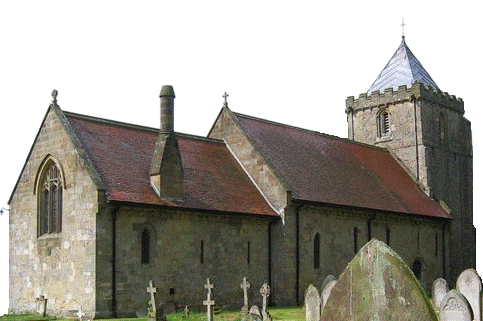 Such
a significant number of our ancestors lived in England prior to the
advent of civil registration, that it is appropriate for many to understand
the scope of available records at the time. This article looks at
those records generated by the parish. Such
a significant number of our ancestors lived in England prior to the
advent of civil registration, that it is appropriate for many to understand
the scope of available records at the time. This article looks at
those records generated by the parish.Pictured: Salton St John de Beverley NRY. |
In
this issue: |
|
Graham Jaunay Services |
| The scope of records produced at the parish level is a feature of the form of governance that had been adopted by England. Most anciently established parishes of the Church of England had, apart from their ecclesiastical function, a civil function as part of the role of an Established Church as an arm of largely local government. This development occurred during the 16th and 17th centuries as the parish gradually superseded the manor as the main unit of local government. As we move into recent times we see this aspect of the church being gradually removed through the 19th century so that by the time we arrive in the 20th century, all civil functions of the church have been divested. As such we can expect to find material relating to all aspects of the lives and beliefs of our English ancestors and a great deal can be discovered about how people lived in the past. Delving into the parish records one can often discover information about: • the fabric of the parish church itself, its associated buildings and churchyards • families who lived within the parish • the fields and houses around the church • local schools and charities • village festivals To pursue records generated by the church, the researcher has to come to an understanding of two main points: 1. Who was responsible for generating the records concerned, and, 2. Where were the records generated likely to be kept. In the church hierarchy certain responsibilities lay at differing levels. These were from the local area through to the whole nation: 1. the parish 2. the archdeaconry 3. the diocese 4. the province 5. the Primate The basic unit in the process was the parish and, for the great majority of records, it is the parish that generated them and it is the parish that preserved them in the parish chest. The task of the researcher is two fold in that when we seek out these records we firstly have to determine the appropriate parish. Once that is established we need to determine where the records are held today. The former can prove an insurmountable task. Over the centuries there have been more than 23,000 Church of England parishes. The vast amount of material generated by the parishes is yet to be indexed in any way and so many researchers spend the bulk of their effort trying to locate the right parish. This has become easier in recent years with the advent of digitised searchable records but the bulk of these relate to the era after the introduction of civil registration in mid-1837. For many Australians, their last ancestral contact with 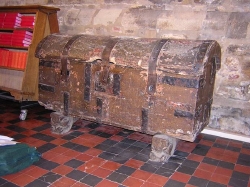 England
dates from this time or earlier and so they do not have the benefit
of either civil registration nor census material to get a starting
point. Nor do the bulk of papers relating to their passage to Australia
or their lives in Australia ever make mention of specific birth places.
Then again, many others face the prospect of sorting through dozens
of people sharing the same names. England
dates from this time or earlier and so they do not have the benefit
of either civil registration nor census material to get a starting
point. Nor do the bulk of papers relating to their passage to Australia
or their lives in Australia ever make mention of specific birth places.
Then again, many others face the prospect of sorting through dozens
of people sharing the same names.The parish chest was long used to store records before it was mandated on 5 Sep 1538 for the purpose of keeping the registers safe. Pictured: a 3-lock parish chest Kings Lynn St Margaret LIN The chest contained much more than parish registers. The starting date for parish registers sounds impressive, but of the approximately 11,000 parishes extant in 1831, only 722 had a starting date of 1538 and by 1910 this number had dropped to 656! All active parishes existing prior to 1597 are deemed ancient parishes. Their original purpose was purely ecclesiastical but the introduction of the 1597 Poor law gave these parishes a civil responsibility as well. After this date we have the creation of civil parishes and ecclesiastical parishes as well as parishes with the dual functions. Parishes with an ecclesiastical function may also include chapelries. 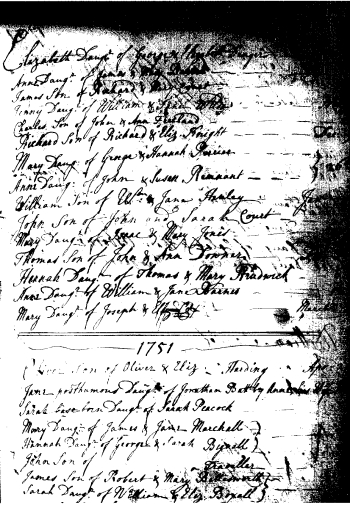 These
are churches within the parish subject to the control of the main
or mother church in the parish. As they grow they often are broken
away to form a parish in their own right. These
are churches within the parish subject to the control of the main
or mother church in the parish. As they grow they often are broken
away to form a parish in their own right.Pictured: Kirdford St John the Baptist SSX parish baptism register. The other matter of significance in 1597 was the decree that all registers were to be on parchment when previously they were on paper. The decree also required that the entries in the former paper registers be copied into the new registers. Due to the wording of the decree, many transcriptions were only backdated to the commencement of the reign of Elizabeth I in 1558 rather than back to 1538. Also from 1597 every year at Easter every incumbent was require to furnish his superior with a transcript of the entries in the register/s for baptisms, marriages and burials. Such records can fill gaps caused by the loss of parish records but should only be sought if trying to locate a person whose parish is not known and not in preference to the parish registers themselves because there is much evidence that these records, collectively known as Bishops' Transcripts, were poorly compiled at the time. The usual practice was to hand the record to the Archdeacon during his visitation and histask was to pass them on to the diocesan registry. This did not always happen. It never happened with those parishes known as peculiars. Peculiars were not, like their neighbours, subject to the local archdeacon and his bishop. While they possessed the same records and kept them in parish chests, they were under the jurisdiction of another organisation or individual, such as the monarch, a peer of the realm, the Knights Templar or Hospitallers, a local or distant religious house, or just the local squire. Most peculiars were abolished in the late 1840s. Some areas were extra-parochial in that they were outside the parish system altogether. There were a variety of reasons including an association with the crown, the site of a religious house or a cathedral including its close and other corporate bodies such as inns of court. Some areas were simply largely devoid of an adequate population needed to maintain a church. A number of these were absorbed into neighbouring parishes by statute in 1858. To determine the status of the place of interest use the informative web site, A vision of Britain through time. The content of parish registers was determined but often not followed on the local level and thus the researcher will find records ranging from minimal information through to the detailed records created under the so-called Dade system (See Newsletter 13). Prior to 1645 there was no requirement on the content of a baptism register, but from then on the record had to include, apart from the name of the baptised and the date of the baptism, the birth date and the parents' names. Printed baptism registers were introduced as a result of the 1812 Rose's Act. The Civil War saw the marriage service become secular. The 1754 Hardwicke Marriage Act regularised marriages and from then they could only be performed on premises licenced accordingly and signatures were required from all the parties involved on printed forms. Of all the registers the marriage can be considered the most complete and accurate followed by the death register and well down the scale, the baptism registers. There was for the most part, no legal way to marry other than in an Anglican Church, synagogue or Quaker meeting house after 1754, whereas children could be born of non-Anglican parents. Technically all children should have been entered into the registers to qualify for parish relief, if and when needed, but there is little doubt that many were not. As to burials, from earliest times and well before the 1689 Toleration Act that allowed non-Anglican church yard cemeteries (but not Catholic ones) to be established, papists, non-conformists, and the unbaptised were often accommodated in the church yard in 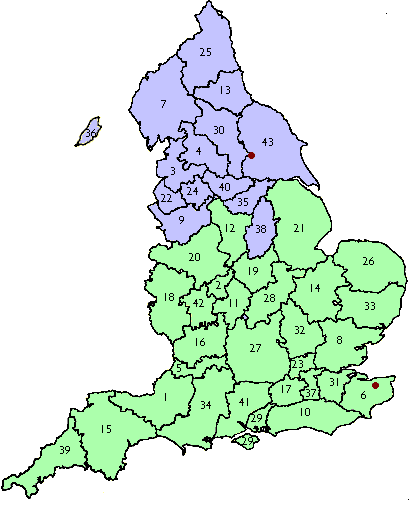 discreet
areas by obliging parish officers. Incidentally with the Hardwicke
Marriage Act the church was required to maintain separate marriage
registers whereas prior to this all baptisms, marriages and burials
were often listed within the one register. discreet
areas by obliging parish officers. Incidentally with the Hardwicke
Marriage Act the church was required to maintain separate marriage
registers whereas prior to this all baptisms, marriages and burials
were often listed within the one register.Pictured: The dioceses of England (& IOM) showing their province.The key is available at the foot of this article. Of all the registers, burials remained the most consistent until Rose's Act in 1812 required them to be on ruled forms requiring name, abode, burial date, age, and officiating person. Prior to this name and date is all that can be expected. Although sometimes wives husbands are named as are children's parents. sometimes cause of death is noted especially plague. Many registers also indicate whether the person was poor and the burial payment came from parish funds (often just the letter p is recorded), woollen affidavit had been sworn (a or aff), and mortuary had been paid (mort). Parishes were grouped into archdeaconries and these in turn made up the diocese. (map adjacent) The incumbent's immediate superior was the archdeacon and he in turn looked to his bishop. The number of archdeaconries in each diocese varied and was determined by the geographical size and population to be managed. Apart from acting as the bishop's agent in collecting up the Bishops's Transcripts and managing the clerics and other staff, the archdeacon was also important when it came to the proving of Wills and the granting of Letters of Administration. This subject raises the matter of the Church Courts in England, a most puzzling arrangement indeed. Essentially there were four levels of courts recognised and these relate to the the persons holding jurisdiction over the parishes. Thus the church was organised into two provinces, Canterbury and York managed by archbishops whose courts were known as prerogative or provincial courts. Of the two, the Province of Canterbury holds sway over York and hence that archbishop is also the Primate of all England. The archbishops' courts recognise a similar hierarchy. Next down the chain, are the courts conducted by the bishops, known as commissary courts in the Province of Canterbury and consistory courts in York. The peculiars' courts were known as local courts and often they were far from local being conducted usually where the manager of the jurisdiction resided. The pity is that this seemingly straightforward arrangement was often ignored! Persons with high social status would often by-pass lesser courts just to maintain their status. Sometimes higher courts would consider matters before them beneath their dignity and would refuse to hear them! The church courts anciently dealt with a great many matters, many of which we today would consider quite secular. Of these the greatest interest to the family history is the proving of Wills and the granting of Letters of Administration which remained the responsibility if the Church of England until 12 Jan 1858. The task for the researcher is determining which court may have dealt with the matter. A bishop had limited dealings with people at the parish level apart from confirmations and many of the matters were managed by the archdeacon. A series of licences could be obtained to gain exemptions from a range of matters from eating meat on a Friday or during Lent though to marriages.It is the latter that is of greater interest in that an alternative to a marriage resulting from the calling of banns in the appropriate parish churches, the couple could seek a licence to marry. To summarise, what could one expect to find in a parish chest can be divided into ecclesiastical and civil records within several classifications and within those there are the core records as well as other incidental or less commonly collated records. Apart from the parish registers covering baptism, marriage and burial, this material may include:
Knowing about the records leads the researcher to the attempt to access the material. Past records of the Church of England are deposited in the Diocesan Record Office and this office is in the cathedral city of the diocese 9see table at the end of this article). The researcher can locate these offices (now under a range of modern names) and the service (if any) they offer to remote clients by simply by googling the name of the office in the list at the end of this article. Material at County Record Offices may be indexed, but with no detail on the Access to Archives (A2A) site. A more appropriate site that will help you through the maze of information and data available is provided by GENUKI [Genealogy United Kingdom & Ireland] and this is a useful site for any information about English records. The records of licences, and probate matters issued by the two archbishops are at the Lambeth Palace Library and The National Archives (Wills) in the case of Canterbury and the Borthwick Institute for York. Records for London and Middlesex are a special case and far from straightforward.The Diocese of London records are at the Guildhall Library and the London Metropolitan Archives.One may also have to search the Lambeth Palace Library and the Westminster Archives for some records and the reader is referred to Gibson, J; Bishops' transcripts and marriage licences, bonds and allegations: a guide to their location and indexes, 2001. It may also be possible to locate the parish records online but the researcher needs to understand that only a tiny fraction of records are available via this process. The site with the most parish registers indexed is the LDS Church FamilySearch web site. If you know the name of the parish concerned then you are better placed approaching the FamilySearch index via the Hugh Wallis web site. Incidentally this site is also useful in that it indicates the range of parish records available at FamilySearch. Of course FamilySearch is only an index and once the appropriate record has been found the researcher needs to order and view the filmed record. This can be done securely online but you will need to nominate the library you will use to view the film.Be sure to also look at the growing number of records not indexed within the IGI. These can be found at the LDS FamilySearch. The British Isles Vital Records Index can be viewed at your local LDS Family History Centre and many other libraries. You can even purchase your own set. It is an index with about 10 million births/baptisms and some 2 million marriages in the British Isles from 1538 to 1888 (with the majority being in England and Wales). Eventually we can expect to see these records on the LDS pilot web site. Boyd's Marriage Index 1538–1840 was compiled by Percival Boyd and his staff extracting the records from over 4,300 parishes making a total of over 7 million names. It is very useful if the marriage did not take place where you expected it to be. The Society of genealogists [SoG] in London holds the originals and British Origins have the licenced online series. At the time of writing not all of the index has been placed online. Boyds Inhabitants of London 1400–1900 which records the families of about 60,000 residents is held by the SoG with a filmed copy at the Guildhall. An attempt was made to include baptism, marriage and death for each member of the family. This material is availbale at British Origins. The National Burial Index 1538–onwards developed by the FFHS and its member societies, a compilation exceeding 18 million burials, can also be seen at SAGHS and other libraries. It is not restricted to Church of England burials. Pallot Marriage and Baptism Indexes is a card index. The marriage index covers mainly London and Middlesex 1780–1837 with 1.8 million names. All but two of the original 103 London parishes are covered. Much of the baptism index, originally containing some 12 million entries, was destroyed by fire and only 200,000 entries survive. The coverage is particularly useful for those London churches destroyed along with their records in the Blitz. The index is owned by 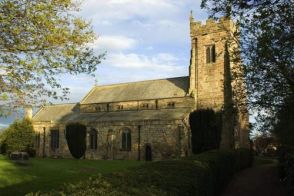 Achievements
Ltd and the indexes can be accessed at Ancestry. Achievements
Ltd and the indexes can be accessed at Ancestry.
Pictured: Catterick St Ann in the Diocese of Ripon. FreeREG is a site being constructed by many volunteers whose goal is to make parish registers freely available. A massive task indeed, made even more significant in that is is covering the whole UK, that has about 10M names already listed. You can view the current coverage by scrolling down the place field on their search engine. Searching the Web, you can also come across other projects of a similar nature. The Cheshire Parish Register Project is a typical example. The Genealogy Archive is another such site. Often such collections can be found by simply Googling the name of the parish of interest. Online Parish Clerks was started in Cornwall and has expanded to other counties as listed on the Kent welcome page. The goal of each clerk is to obtain and collect as many records for a chosen parish as is possible. The gathered information is to be shared with all personal and private researchers by making it freely available either online or by way of written lookup requests. The reader is also encouraged to make contact with the appropriate county family history group to see if they have collated materail from parish records. Most are affliated with The Federation of Family History Societies and their web addresses and contact details are available via this organisation. Several PayToUse web sites have parish registers available online. Ancestry.com has some London and Yorkshire parishes available for baptisms, banns, marriages and burials, Pallot's Marriage Index, and sundry other items which can be viewed online. The Genealogist (see link at head of this and every newsletter) has a much larger collection. You can view the coverage that includes printed books and transcripts. FindMyPast also has a collection of parish registers which can be searched for a fee. You can view FindMyPast coverage online. While Ancestry.com is quite commonly accessible freely at public libraries, you are less likely to find the other sites mentioned although the SA Genealogy & Heraldry Society has FindMyPast available free to library users. We need not lock ourselves into online research as there are many organisations publishing hard copies of parish registers. Some of this material can also be accessed on CD. A list of CDs published by S&N is available online. The SA Genealogy & Heraldry Society has a number of these and others published by the various English family history societies. Check your local family history library or hunt out the appropriate English county family history society. They are all listed on GENUKI. Note: If you decide to subscribe to The Genealogist please show your support for this newsletter by opening your subscription via the link at the top of this page. This article has been about Church of England parish chests, however, many denominations, other than the Church of England maintained parish registers recording baptisms and burials. Catholic, non-conformist and Jewish records will be addressed in a future newsletter. There are also the records generated by the Bishops and these too will be addressed at a future date. The dioceses of the Established Church of England (see above illustration)
The dioceses are grouped into two provinces. Each diocese is subdivided into archdeaconries. Archdeaconries are composed of parishes. More often than not the diocesan records are currently arranged by county rather than diocese. The web sites often detail the precise records held in the collection.
|
|||||||||||||||||||||||||||||||||||||||||||||||||||||||||||||||||||||||||||||||||||||||||||||||||||||||||||||||||||||||||||||||||||||||||||||||||||||||||||||||||||||||||||||||||||||||||||||||||||||||||||||||||||||||||||||||||||||||||||||||||||||||||||||||||||||||||||||||||||||||||||||||||||||||||||||||||||||||||||||||||
| To
unsubscribe send a blank email via the following link using the same
address you subscribed to: newsletter-leave@jaunay.com |
|||||||||||||||||||||||||||||||||||||||||||||||||||||||||||||||||||||||||||||||||||||||||||||||||||||||||||||||||||||||||||||||||||||||||||||||||||||||||||||||||||||||||||||||||||||||||||||||||||||||||||||||||||||||||||||||||||||||||||||||||||||||||||||||||||||||||||||||||||||||||||||||||||||||||||||||||||||||||||||||||